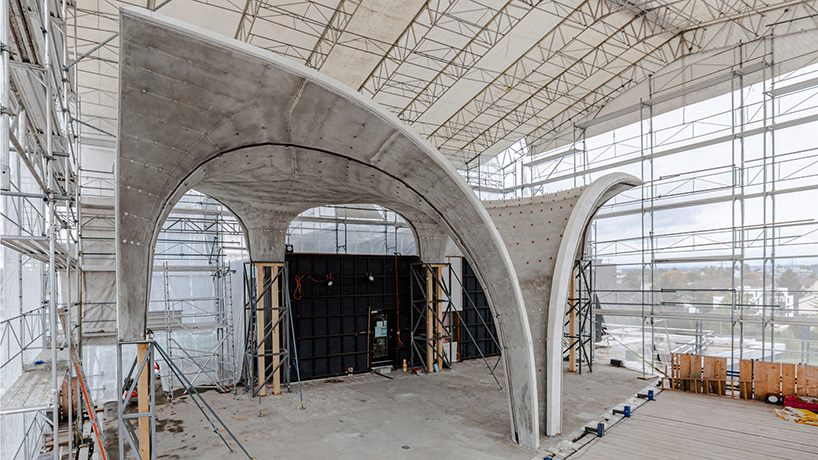
Doubly Curved Shell Roof Units
Description:
Building Material Category: Modular Components
Building Component Type: Roof
Alternative for Conventional Building Material: Traditional flat or pitched roof systems, such as asphalt shingles, metal sheets, or concrete slabs
Introduction: Doubly curved shell roof units are innovative architectural elements characterized by their complex, curved geometry that can create aesthetically striking and structurally efficient roofs. These units are designed to provide both functional and visual benefits, offering unique design possibilities and structural performance advantages. These roof units are crafted from materials such as reinforced concrete, fiberglass, or advanced composites, allowing for the creation of elegant, sweeping forms that can span large areas without the need for traditional supports. Their unique shape not only enhances the visual impact of a building but also delivers significant thermal performance advantages. The curved design improves natural ventilation and airflow, reducing the need for mechanical cooling and heating. By minimizing direct solar gain and optimizing shade distribution, doubly curved shell roofs can effectively lower indoor temperatures, thereby decreasing energy consumption and enhancing overall comfort. This combination of striking design and practical benefits makes doubly curved shell roof units an innovative solution for modern architectural challenges.
Composition: It is typically made from reinforced concrete, fiberglass, or advanced composite materials. The shell structure may incorporate a combination of materials to optimize strength, flexibility, and thermal performance.
Applicability in Climatic Zone: It is suitable for all climatic zones in India, depending on specific formulations of thermal loads, snows loads and wind zones for main wind direction. For warm and humid climates, it provides excellent shading and cooling benefits due to its curved geometry, which helps in reducing direct solar gain. For temperate climates it is effective in managing rainwater runoff and snow load due to its aerodynamic shape. For hot and dry climates it can be designed to minimize heat absorption and enhance cooling.
Use: It is ideal for architectural projects requiring innovative roof designs, such as cultural centers, sports facilities, and modern office buildings. It is suitable for large-span roofs where traditional materials may not be as effective or aesthetically desirable.
Thermal Performance: The doubly curved shape can improve natural ventilation and air circulation within the building, contributing to overall energy efficiency. The design helps in reducing heat gain and improving comfort by minimizing the exposure of the interior to direct sunlight.
Thermal Conductivity: The thermal conductivity of the material used can vary depending on composition. For reinforced concrete shell it is typically around 1.7 W/m·K, for fiberglass shell it ranges from 0.04 to 0.05 W/m·K and for composite materials shells it can be engineered to achieve low thermal conductivity values.
Thermal Transmittance: It depends on the thickness and material composition of the shell units. Well-designed units can achieve low U-values, enhancing thermal insulation performance. For reinforced concrete shell it typically ranges from 2.0 to 3.0 W/m2·K, for reinforced polymer shells it can range from 0.5 to 1.5 W/m2·K and for composite material shells it can range from 0.4 to 1.2 W/m2·K.
Reduction in CO2 Emission: Appropriate materials and design selection can reduce the amount of material needed and associated CO2 emissions during production. The enhanced thermal performance reduces heating and cooling energy consumption, leading to lower operational CO2 emissions over the building's lifespan.
Salient Features:
-
Architectural Aesthetics: It offers a striking, futuristic look with flexible, customizable curved forms.
-
Structural Efficiency: It efficiently distributes loads, allowing for large spans with reduced support.
-
Enhanced Thermal Performance: It improves natural ventilation and reduces heat gain, lowering cooling needs.
-
Efficient Rainwater Management: It promotes effective rainwater runoff, minimizing pooling.
-
Acoustic Performance: It provides enhanced sound insulation, reducing external noise.
-
Durability and Maintenance: It is resilient to environmental stressors and requires minimal maintenance.
-
Sustainability Benefits: It reduces energy consumption and carbon footprint through efficient design and materials.
-
Innovative Construction Techniques: It utilizes advanced fabrication and modular construction for high-quality results.
Indian Codes:
-
IS 456:2000 - Code of Practice for Plain and Reinforced Concrete-Guidelines for designing and constructing reinforced concrete structures, applicable to curved shell elements.
-
IS 1343:1980 - Code of Practice for Prestressed Concrete-Covers design and construction practices for prestressed concrete, relevant for certain doubly curved shell applications.
-
NBC 2016 - National Building Code of India-Comprehensive guidelines on structural design and construction, including principles for curved shell roofs.
-
IS 800:2007 - General Construction in Steel – Code of Practice-Provides general structural principles relevant for hybrid or composite shell structures.
-
IS 6322:1984 - Code of Practice for Construction of Floor and Roof Units Using Precast Doubly Curved Shell Units-Specific guidelines for the construction, design, and quality standards of precast doubly curved shell units.
International Codes:
-
Eurocode 2: Design of Concrete Structures-Provides comprehensive guidelines for the design of concrete structures, including advanced forms like doubly curved shells, ensuring structural integrity and safety.
-
ACI 318: Building Code Requirements for Structural Concrete-Offers standards and requirements for the design and construction of structural concrete, applicable to curved and complex shell structures.
-
BS 8110: Structural Use of Concrete-Details the design and construction standards for concrete structures, including those with curved geometries.
-
ISO 2394: General Principles on Reliability for Structures-Provides principles for ensuring the reliability of structural designs, including those involving advanced shell structures.
-
JBC (Japanese Building Code) - Includes provisions for the design and construction of various structural systems, including complex shell structures, ensuring compliance with safety and performance standards.
Sources: